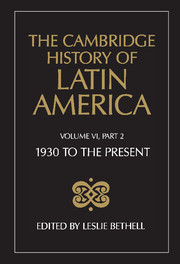Book contents
7 - Women in twentieth-century Latin American society
from Part Three - Society and politics
Published online by Cambridge University Press: 28 March 2008
Summary
For Latin American women the twentieth century has brought significant changes in legal status, education, participation in the labour force, citizenship and political participation. Such changes have not been linear and progressive. Gradual shifts rather than sudden movements have characterized the process of change. Innovations have been met with resistance from individuals of both genders, or from socio-economic groups upholding traditional patterns of behaviour and cultural attitudes. Yet, on balance, there has been an important transformation. That such transformation has neither resulted in equality between the sexes nor resolved the inequalities between women of different economic or ethnic background does not lessen its historical significance.
Regional and national political factors, and economic and ethnic disparities, make generalizations regarding all women in the whole continent somewhat difficult. The opportunities for education, the access to better jobs and health care have been greater in capital cities than in the hinterlands; in certain countries legal and social forms of female subordination have persisted longer than in others. Yet, patterns which apply to the majority of women are still clearly perceivable when seen from the perspective of history. Similarities and differences, as well as the main threads of women’s history, are best appreciated in three areas of activities: labour, education and social and political movements. These reflect the tensions between change and tradition, the contrasts created by social, ethnic and national differences. Overall, these themes also reflect the complexities of gender experiences, and are intimately interconnected with each other, even if for the sake of analysis they are dealt with separately.
- Type
- Chapter
- Information
- The Cambridge History of Latin America , pp. 483 - 544Publisher: Cambridge University PressPrint publication year: 1995
References
- 2
- Cited by



